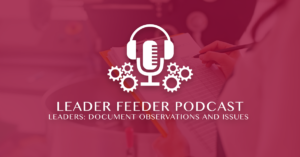The Importance of Productivity
Productivity should be a major focal point for virtually every leader, because your team’s output has a direct impact on revenue and cost. Productivity is how much output your team can generate within the resources you have available. The more you can produce with the resources available, the greater the value your team generates. A […]
Read MoreAvoid Communication Confusion
Words can be interpreted differently by different people, so it’s important as a leader to avoid communication confusion. Leaders who use vague words can be easily misinterpreted. Here are just a few examples: “That employee is always late.” “Sometimes the machine is down.” “We almost never have an issue with that supplier.” The problem with […]
Read MoreIs it Skill or Will?
Is it a matter of skill or is it will? That’s the question you need to ask yourself when a team member isn’t meeting your expectations as a leader. Knowing whether the gap in performance is a skill issue or a motivation problem helps you gain the clarity you need to create the most effective solution. […]
Read MoreLeaders: Document Observations and Issues
There are two main reasons that leaders should document observations, questions and issues: Provide back up for any disciplinary actions. Ensure employee questions and issues get addressed and closed out. It isn’t uncommon for supervisors to rush to the HR department with an employee issue and want to provide disciplinary action only to discover that […]
Read MoreCreating a Sense of Urgency
It isn’t unusual for leaders to complain that their team members are lazy, work harder at avoiding work than actually doing the work, and have no sense of urgency when it comes to completing tasks. The pace of work in any environment is important because the more you can produce, the better the results. So, […]
Read MoreCreating a High-Performance Team
A fragmented team rarely creates results. So, how exactly can you create a strong sense of teamwork and collaboration in your team? In one of our workshops, we have people take two minutes to brainstorm all the items they can think of that have a certain attribute or characteristic. We find that people will list, […]
Read MoreLeaders: Watch Your Tone
It’s not what you say, it’s how you say it. Most leaders underestimate how truly powerful this piece of advice can be. As a front line leader, supervisor or manager, how you say things to your team will impact their motivation, engagement and performance. One of the classic ways leaders mess up the tone and […]
Read MoreHelp Employees Become Process Experts
Many leaders complain about having their team members relying on them to answer every question, troubleshoot every problem and make every decision. They want their employees to think for themselves, do basic troubleshooting and make certain decisions. When questions come up and machines break down, someone needs to come up with a solution. But, you […]
Read MoreLeaders: Hands on, or Hands off?
As a leader, is it better to be hands on or hands off with your workgroup? As with many leadership questions, there isn’t always a clear answer between one or the other. One of our clients had us develop their front line leaders because their tendency was to grab a wrench and solve all the […]
Read MoreAvoiding a Culture of Cheating
It’s an unfortunate truth, but some people feel the need to cheat or fudge the results in order to meet the expectations of their leadership team. There have been press stories recently about people who have been less than honest with quality control reports, and you may have seen evidence in your own organization of […]
Read More








